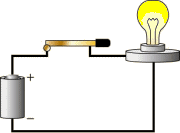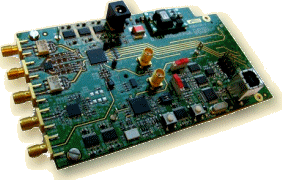 Usually, when we think of circuits, we think about a roughly circular path that ends in the same place it started, then repeats – like an electrical circuit
Usually, when we think of circuits, we think about a roughly circular path that ends in the same place it started, then repeats – like an electrical circuit  or Escher’s fantastic circuit. But when people are talking about neural circuits, they seem to be using the term more like it’s used in the phrase, circuit boards, those peculiar green thingees that populate the gizmos that make our lives work.
or Escher’s fantastic circuit. But when people are talking about neural circuits, they seem to be using the term more like it’s used in the phrase, circuit boards, those peculiar green thingees that populate the gizmos that make our lives work.
In fact, when experts diagram their neural circuits, the figures even look a bit like those boards with their  discrete elements [chips and the like] connected with rows of rigid copper conductors scurrying from element to element. But as tempting as it is, making analogies between computer hardware [or, for that matter, other electric circuitry] and the brain doesn’t hold much further than this.
discrete elements [chips and the like] connected with rows of rigid copper conductors scurrying from element to element. But as tempting as it is, making analogies between computer hardware [or, for that matter, other electric circuitry] and the brain doesn’t hold much further than this.
by DeLong MR and Wichmann TJAMA Neurology. 2015 72[11]:1354-1360.
IMPORTANCE: The revival of stereotactic surgery for Parkinson disease [PD] in the 1990s, with pallidotomy and then with high-frequency deep brain stimulation [DBS], has led to a renaissance in functional surgery for movement and other neuropsychiatric disorders.OBJECTIVE: To examine the scientific foundations and rationale for the use of ablation and DBS for treatment of neurologic and psychiatric diseases, using PD as the primary example.EVIDENCE REVIEW: A summary of the large body of relevant literature is presented on anatomy, physiology, pathophysiology, and functional surgery for PD and other basal ganglia disorders.FINDINGS: The signs and symptoms of movement disorders appear to result largely from signature abnormalities in one of several parallel and largely segregated basal ganglia thalamocortical circuits [ie, the motor circuit]. The available evidence suggests that the varied movement disorders resulting from dysfunction of this circuit result from propagated disruption of downstream network activity in the thalamus, cortex, and brainstem. Ablation and DBS act to free downstream networks to function more normally. The basal ganglia thalamocortical circuit may play a key role in the expression of disordered movement, and the basal ganglia-brainstem projections may play roles in akinesia and disturbances of gait. Efforts are under way to target circuit dysfunction in brain areas outside of the traditionally implicated basal ganglia thalamocortical system, in particular, the pedunculopontine nucleus, to address gait disorders that respond poorly to levodopa and conventional DBS targets.CONCLUSIONS AND RELEVANCE: Deep brain stimulation is now the treatment of choice for many patients with advanced PD and other movement disorders. The success of DBS and other forms of neuromodulation for neuropsychiatric disorders is the result of the ability to modulate circuit activity in discrete functional domains within the basal ganglia circuitry with highly focused interventions, which spare uninvolved areas that are often disrupted with drugs.
[adapted from the paper]
When I was in medical school, we all learned about some neural circuits – the ones that were known then: like the motor system [how the cortex send messages to the muscles] or the visual system [how the sensors in the eye connect to the visual cortex at the back of the brain]. Those two actually are like wiring diagrams and important for localizing brain lesions [tumors, strokes]. But the only thing I remember knowing about the Movement Disorders like Parkinson;s Disease is that they involved the extrapyramidal [postural] system which had something to do with the mysterious basal ganglia structures deep in the brain.
But now, the basal ganglia thalamocortical circuits are better characterized [above]. The boxes are brain structures/regions and the arrows are the ways in which they act on each other to make the system work. These circuits are spatially distant from the voluntary motor system, so they can be manipulated without loss of function. In this same article, there’s a figure that shows the abnormalities in Parkinson’s Disease, followed by another that shows where the symptoms arise and where treatments act. Now they know enough to successfully treat medication resistant disabling symptoms with surgical lesions or deep brain modulation, putting this basic science to direct clinical use.
So we have a primitive understanding of this particular neural circuit – something like a highway map. It tells how to get from place to place, but not much about what happens in the places the roads connect. There are undoubtedly a myriad of such functional neural circuits with similar nodes, pathways, and feedback loops in our brains just doing their various jobs whether we yet know about them or not. And it’s sure easy to see why neuroscientists of various ilks are so eager to know a lot more about them – and ultimately how to safely tweak them when they sputter and cause dis·ease.
British Medical Journal1 September 2011… The seismic shift had been driven by what he [Tom Insel] described as three “revolutionary changes” in thinking, the first of which was that mental illness was increasingly being recognised as a disorder of brain circuitry, rather than as a chemical imbalance, thanks to neuroimaging techniques and the discovery of some key biomarkers…
Even in his exuberance, I kind of wish Dr. Insel had said "some mental illness might even turn out to be disorders of brain circuitry." But whatever he said isn’t the point. This post is my attempt at an introduction to exploring what I started in weary…, the Decade of “Jumping the Gun“…., and this comment.

Sorry, the comment form is closed at this time.